Azerbaijan Gobustan Rock Art
Exploring the Azerbaijan Gobustan Rock Art is like stepping back in time to witness humanity’s earliest artistic expressions etched into stone. Located just southwest of Baku, this UNESCO World Heritage site features over 6,000 rock engravings dating back up to 40,000 years, offering a fascinating glimpse into ancient civilizations. As you wander through this open-air museum, you’ll discover depictions of prehistoric life, from hunting scenes and ritual dances to ancient boats and wildlife, all set against a dramatic landscape of mud volcanoes and rocky hills. The Azerbaijan Gobustan Rock Art isn’t just a collection of carvings; it’s a profound cultural treasure that connects modern travelers with our shared human heritage. Whether you’re a history buff, an adventure seeker, or simply curious about ancient cultures, this destination provides an unforgettable journey through time. You’ll find yourself marveling at how these intricate artworks have survived millennia, telling stories that still resonate today. Planning your visit requires some insight into the best times to go, what to expect, and how to make the most of your experience, which we’ll cover in detail throughout this guide.
Azerbaijan Gobustan Rock Art – Essential Information
Understanding the Azerbaijan Gobustan Rock Art begins with appreciating its historical and cultural significance. This vast archaeological reserve spans approximately 537 hectares and is divided into several key areas, each with unique petroglyphs and geological features. The rock carvings primarily depict animals like gazelles and wild bulls, human figures engaged in various activities, and symbolic patterns that scholars believe represent early spiritual beliefs. You’ll notice that the art varies in style and complexity, reflecting different periods from the Upper Paleolithic to the Middle Ages. Visiting the site involves walking along marked trails, with informational signs in English to help you interpret the scenes. The nearby Gobustan Museum enhances the experience with detailed exhibits, including replicas and multimedia displays that provide context for the outdoor discoveries. As you explore, keep in mind that the terrain can be uneven, so wearing sturdy shoes is essential for a comfortable and safe visit.
What is Gobustan Rock Art? – A Historical Overview
- The petroglyphs date from 40,000 to 5,000 years ago, showcasing the evolution of human expression and societal changes over millennia.
- Many carvings include scenes of communal life, such as hunting and dancing, offering insights into the daily routines and beliefs of ancient inhabitants.
- Archaeologists have identified over 6,000 engravings, with new discoveries still being made, making it a living site of ongoing research and preservation.
- Budget option: Entry fees start at around $5 USD per person, and public transportation from Baku costs under $10 USD round trip, allowing for a full day under $50 including meals.
- Mid-range option: Guided tours from Baku range from $50 to $100 USD per person, covering transport, entry, and expert commentary, with added comfort like air-conditioned vehicles.
- Luxury option: Private tours with extended itineraries, including multi-day packages with premium accommodations and exclusive access, can cost $200 USD or more per person.
- UNESCO World Heritage Centre – Gobustan Rock Art Cultural Landscape
- Azerbaijan Tourism Board – Official Travel Information
UNESCO World Heritage Status – Why It Matters
Designated as a UNESCO World Heritage site in 2007, the Azerbaijan Gobustan Rock Art gains international recognition for its outstanding universal value. This status helps protect the area from development and ensures that conservation efforts are prioritized, allowing future generations to enjoy its wonders. As a visitor, you contribute to these preservation initiatives through entry fees, which fund maintenance and educational programs. The UNESCO listing also highlights the site’s role in understanding human migration patterns and cultural exchanges across the Caucasus region. You’ll find that the designation has improved infrastructure, such as better pathways and visitor facilities, making your trip more accessible and informative.

Azerbaijan Gobustan Rock Art – Planning Your Trip
Planning your visit to the Azerbaijan Gobustan Rock Art involves considering factors like weather, budget, and preparation to ensure a smooth and enriching experience. The site is accessible year-round, but seasonal variations can affect your comfort and the quality of your exploration. You’ll want to allocate at least half a day to fully appreciate the rock carvings and surrounding landscape, with options for guided tours or self-guided walks. Budget-wise, expenses can range from affordable DIY trips to more luxurious guided experiences, so it’s helpful to outline your priorities early. Additionally, preparing for the terrain and climate will enhance your enjoyment; packing water, sun protection, and comfortable clothing is crucial. This section breaks down the key elements to help you create an itinerary that suits your interests and needs, whether you’re traveling solo, with family, or in a group.
Best Time to Visit Gobustan Rock Art
The ideal time to explore the Azerbaijan Gobustan Rock Art is during the spring (April to June) or autumn (September to October) when temperatures are mild, ranging from 15°C to 25°C (59°F to 77°F). During these seasons, you’ll avoid the extreme heat of summer, which can exceed 35°C (95°F), making outdoor walks uncomfortable. Spring brings lush greenery and wildflowers, adding to the scenic beauty, while autumn offers clear skies and fewer crowds. Winter visits are possible but less recommended due to chilly weather and potential rain, though you might enjoy lower prices and solitude. If you’re planning a summer trip, aim for early morning or late afternoon to beat the heat and capture better photos of the rock art in soft light.
Budget Planning and Costs
Essential Preparation Checklist
Before heading to the Azerbaijan Gobustan Rock Art, ensure you have comfortable walking shoes, a hat, sunscreen, and plenty of water, as shade is limited on the trails. Pack a camera or smartphone for photos, but remember that flash photography is prohibited to preserve the artworks. It’s also wise to carry some local currency (Azerbaijani Manat) for small purchases, though credit cards are accepted at the museum. Check visa requirements if needed; US and EU passport holders typically receive a 30-day visa on arrival or can apply for an e-visa online. Lastly, download offline maps or a translation app, as English signage is available but not comprehensive, helping you navigate and appreciate the cultural nuances independently.
Azerbaijan Gobustan Rock Art – Top Attractions and Activities
Your visit to the Azerbaijan Gobustan Rock Art will be filled with awe-inspiring sights and engaging activities that bring ancient history to life. The main highlights include the densely carved rock panels, where you can spot intricate depictions of prehistoric life, and the nearby mud volcanoes, which add a unique geological twist to the experience. As you explore, you’ll have opportunities for photography, guided interpretations, and even interactive exhibits at the museum. Beyond the famous spots, venturing to lesser-known areas reveals hidden gems that offer a more intimate connection with the past. This section guides you through the must-see attractions and suggests ways to deepen your adventure, ensuring you don’t miss any of the cultural richness this site has to offer.
Must-See Highlights – Key Rock Art Panels
Among the essential stops are the Boyukdash and Kichikdash mountain areas, where you’ll find the most concentrated and well-preserved petroglyphs. Look for the famous “Gaval Dash” or tambourine stone, which produces a musical sound when struck, and carvings of ancient boats that hint at early seafaring traditions. The museum’s indoor exhibits provide context with 3D models and audio guides, making it easier to understand the symbolism behind the art. You should also allocate time for the surrounding landscape, including the bubbling mud volcanoes, which are among the largest in the world and offer a surreal contrast to the historical carvings. These highlights collectively create a multifaceted experience that blends nature, history, and culture.
Hidden Gems and Local Favorites
Venture beyond the main trails to discover less crowded spots like the Yazili Hill area, where quieter rock art panels allow for uninterrupted contemplation. Local guides often share stories about lesser-known carvings that depict unique scenes, such as ritual ceremonies or rare animal species, adding depth to your visit. Another hidden gem is the nearby village of Gobustan, where you can interact with residents and learn about contemporary Azerbaijani culture, perhaps enjoying a traditional meal. These off-the-beaten-path experiences provide a richer, more personal connection to the site and its heritage, making your trip memorable beyond the typical tourist route.
Azerbaijan Gobustan Rock Art – Practical Travel Information
Navigating the practical aspects of your trip to the Azerbaijan Gobustan Rock Art ensures a hassle-free adventure. Transportation options include buses, taxis, or organized tours from Baku, with the journey taking about an hour by road. Once there, you’ll find basic amenities like restrooms and a café, but it’s best to bring snacks and water for extended stays. Accommodation choices range from budget-friendly guesthouses in nearby towns to upscale hotels in Baku, allowing you to tailor your stay to your comfort and budget. This section provides detailed advice on getting around, where to sleep, and other logistical tips to help you plan efficiently, so you can focus on immersing yourself in the ancient wonders.
| Category | Options/Features | Price Range (USD) |
|---|---|---|
| Accommodation | Guesthouses in Gobustan village or hotels in Baku with shuttle services | $30-$150 per night |
| Transportation | Public buses, private taxis, or rental cars from Baku | $10-$50 round trip |
| Guided Tours | Half-day to full-day tours with English-speaking guides | $20-$100 per person |


